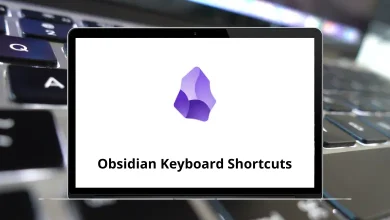25 Best Online Learning Techniques for College Students
Online learning isn’t just about logging into Zoom and listening to lectures. It’s a whole new way of learning that gives you flexibility but also demands focus, strategy, and smart habits.
Table of Contents
- 1 1. Create a Dedicated Learning Space
- 2 2. Stick to a Study Schedule
- 3 3. Treat Online Classes Like Real Classes
- 4 4. Break Down Big Topics into Small Goals
- 5 5. Take Smart Digital Notes
- 6 6. Engage Actively in Online Discussions
- 7 7. Use Visual Learning Techniques
- 8 8. Manage Screen Fatigue
- 9 9. Record and Replay Lectures
- 10 10. Practice Active Learning
- 11 11. Use Online Productivity Tools
- 12 12. Avoid Multitasking
- 13 13. Take Regular Breaks
- 14 14. Build an Accountability System
- 15 15. Apply What You Learn Immediately
- 16 16. Use Gamification to Stay Motivated
- 17 17. Stay Physically Active
- 18 18. Manage Your Time Wisely
- 19 19. Seek Feedback Regularly
- 20 20. Keep a Learning Journal
- 21 21. Balance Screen Time and Offline Time
- 22 22. Build a Personal Knowledge Base
- 23 23. Reward Yourself
- 24 24. Keep Updating Your Tech Skills
- 25 25. Stay Consistent and Patient
- 26 Final Thoughts
Whether you’re taking a full-time degree online or using platforms like Coursera, Udemy, or Khan Academy to boost your skills, this guide breaks down practical online learning techniques that actually work for college students.
1. Create a Dedicated Learning Space
Let’s start with the basics your environment.
When you study in the same spot every day, your brain associates that place with focus and learning. It doesn’t have to be fancy; a quiet corner with good lighting, a comfortable chair, and a clean desk works wonders.
Quick Tips:
- Keep your phone away or on silent.
- Use noise-canceling headphones if your house is noisy.
- Decorate your space with motivational quotes or plants.
- Close extra browser tabs (except your study tools).
If you often multitask between study tools, try using keyboard shortcuts in apps like Google Docs Shortcuts or MS Word Shortcut Keys to save time.
2. Stick to a Study Schedule
Without a fixed timetable, online learning can easily drift into chaos. Set a daily or weekly schedule that includes your classes, self-study, breaks, and even time for scrolling social media.
Here’s how to plan it smartly:
- Use Google Calendar to set reminders for your live classes.
- Apply the Pomodoro Technique 25 minutes of focus + 5 minutes break.
- Reserve tougher subjects for when your energy peaks (morning or late night).
- Don’t overload schedule realistic goals per day.
You can also use apps like Todoist or Notion (check out Notion Shortcuts) to manage your tasks efficiently.
3. Treat Online Classes Like Real Classes
The biggest mistake many college students make is treating online classes casually. Just because your professor isn’t physically there doesn’t mean it’s optional.
Do this instead:
- Log in 5 minutes early.
- Take notes actively don’t just watch passively.
- Keep your camera on if possible it keeps you accountable.
- Ask questions in chat or discussion forums.
If you use apps like Zoom or Microsoft Teams, learning their shortcuts can help you engage faster (mute/unmute, screen share, chat toggle, etc.) Try Zoom Shortcuts or Microsoft Teams Shortcuts.
4. Break Down Big Topics into Small Goals
Feeling overwhelmed by a huge syllabus? Break it down.
Instead of saying “I’ll study Biology today,” break it into micro-tasks like:
- Read Chapter 1: Cell Structure
- Watch the lecture video
- Make flashcards
- Revise notes
Each small win keeps you motivated and builds momentum. You can manage this efficiently using tools like Trello or Google Keep. (Here’s a list of Google Keep Shortcuts to stay faster.)
5. Take Smart Digital Notes
Digital notes are your best friend in online learning. They’re easy to organize, search, and sync across devices.
Best Tools for Taking Notes:
- OneNote – Great for structured notebooks. (OneNote Shortcuts)
- Evernote – Excellent for web clipping and tagging. (Evernote Shortcuts)
- Google Docs – Simple and collaborative.
- Notion – Combines note-taking, tasks, and databases.
Use headings, bullets, highlights, and color codes for better recall. You’ll thank yourself during exams.
6. Engage Actively in Online Discussions
Discussion boards might feel awkward at first, but they’re goldmines for understanding concepts deeply.
How to Make It Work:
- Ask meaningful questions.
- Reply thoughtfully to classmates instead of “I agree.”
- Summarize what others said and add your own insights.
- Share relevant resources or examples.
These interactions mimic the traditional classroom feel and help you build relationships something many online learners miss.
7. Use Visual Learning Techniques
Not everyone learns best by reading text. Visual learners thrive on diagrams, charts, and videos.
Try These Visual Learning Tricks:
- Watch explainer videos on YouTube or Khan Academy.
- Create mind maps using Canva or Miro.
- Use infographics to summarize complex topics.
- Convert your notes into visual flashcards using Quizlet.
If you’re a design student, mastering tools like Adobe Illustrator or Photoshop can level up your presentation quality here are Illustrator Shortcuts and Photoshop Shortcut Keys to make your creative workflow faster.
8. Manage Screen Fatigue
Online learning means long hours in front of screens. Eye strain, headaches, and fatigue are real problems.
Simple Fixes:
- Follow the 20-20-20 rule: every 20 minutes, look 20 feet away for 20 seconds.
- Use blue light filters like f.lux or built-in “Night Mode.”
- Keep room lighting balanced not too dim or too bright.
- Adjust your chair and monitor height for better posture.
If you edit videos or presentations often, learning Adobe Premiere Pro Shortcuts can reduce the time spent staring at your screen.
9. Record and Replay Lectures
One of the biggest perks of online learning is recorded lectures. You can pause, rewind, and rewatch anytime—something traditional classrooms can’t offer.
How to Use Them Effectively:
- Replay complex parts at 1.25x speed for better comprehension.
- Summarize after each section.
- Don’t binge-watch space it out with active recall sessions.
Apps like VLC Media Player let you control playback speeds easily. If you’re new to it, see the VLC Shortcuts for quick control tips.
10. Practice Active Learning
Active learning simply means engaging your brain not just consuming information.
Examples:
- Teach what you learned to someone else.
- Create quizzes or flashcards.
- Write short summaries after each lecture.
- Discuss concepts with peers or online study groups.
This method improves retention far more than passive note-taking.
11. Use Online Productivity Tools
When your studies depend entirely on digital tools, productivity apps become lifesavers.
Recommended Tools:
- Google Drive – For storing assignments. (Google Drive Shortcuts)
- Dropbox – For sharing big files.
- Grammarly – For proofreading essays.
- Trello – For project management.
- Focus To-Do – For Pomodoro timing.
Knowing how to navigate these efficiently saves hours. For example, Google Sheets Shortcuts help you analyze data quickly when working on projects.
12. Avoid Multitasking
It’s tempting to open Netflix or scroll Instagram while attending a lecture but multitasking kills focus and retention.
How to Fix It:
- Use browser extensions like “StayFocusd” or “Cold Turkey” to block distractions.
- Keep only essential tabs open.
- Use a second screen only if it adds productivity.
Research shows that task-switching can reduce efficiency by up to 40%. So, one thing at a time it’s faster in the long run.
13. Take Regular Breaks
Burnout is the biggest enemy of consistent learning. Taking breaks helps your brain recharge and improves long-term focus.
Try This Routine:
- Study 50 minutes → Break 10 minutes.
- After 3 cycles, take a 30-minute break.
- Stretch, hydrate, or walk don’t check your phone.
During long breaks, try some creative hobbies like photo editing using Lightroom Shortcuts or designing posters with Canva Shortcuts.
14. Build an Accountability System
Learning alone can get lonely. That’s where accountability comes in.
How to Build One:
- Join online study groups or Discord communities.
- Partner with a classmate to check in weekly.
- Share your progress on social media or in a group chat.
- Set small public goals (“I’ll finish Chapter 3 by Friday”).
Accountability transforms online learning from isolation into teamwork.
15. Apply What You Learn Immediately
The faster you apply what you learn, the better it sticks.
Here’s how:
- If you’re learning coding, build a mini project.
- If you’re learning design, recreate real-world posters.
- If you’re learning finance, try managing a mock budget.
Use free platforms like GitHub, Behance, or even Canva to put theory into action. This not only builds skill but also a portfolio you can showcase later.
16. Use Gamification to Stay Motivated
Online learning platforms now include gamified elements badges, levels, and streaks to make studying fun.
You Can Try:
- Duolingo for language learning.
- Khan Academy for daily streak goals.
- Habitica for turning tasks into an RPG game.
- Quizizz for interactive learning quizzes.
These keep your motivation alive, especially when classes get monotonous.
17. Stay Physically Active
A healthy body means a sharper mind. Online classes often make students sit for long hours don’t fall into that trap.
Simple Habits:
- Do quick stretches between lectures.
- Take short walks after classes.
- Drink enough water throughout the day.
- Avoid junk snacks during study time.
Physical health directly impacts cognitive performance, so treat your body like part of your learning toolkit.
18. Manage Your Time Wisely
Time management is everything in online learning. Between assignments, projects, and part-time jobs, every minute counts.
Here’s What Helps:
- Prioritize tasks using the Eisenhower Matrix (urgent vs. important).
- Set weekly goals and reflect every Sunday.
- Track where your time goes using tools like RescueTime.
Combine it with keyboard efficiency like using Windows Run Commands to open tools instantly.
19. Seek Feedback Regularly
Don’t wait until finals to discover what you misunderstood. Ask your instructors for feedback regularly—on assignments, participation, or projects.
You Can:
- Email your professor directly.
- Attend virtual office hours.
- Ask peers to review your work.
- Use grading rubrics to self-check before submission.
Feedback closes the loop between learning and improvement.
20. Keep a Learning Journal
Tracking progress makes you see how far you’ve come. A learning journal helps you reflect on your strengths, weaknesses, and study habits.
What to Include:
- What you studied today.
- What went well.
- Where you struggled.
- One improvement for tomorrow.
You can maintain it digitally in apps like Notion or Google Docs again, shortcuts make it faster and less boring.
21. Balance Screen Time and Offline Time
Even though your courses are online, some of the best learning happens offline reading physical books, writing by hand, or brainstorming on paper.
Mix It Up:
- Use digital for lectures and assignments.
- Use pen and paper for idea mapping or memorization.
- Go offline during revision days to cut distractions.
Blending both worlds gives you the best of focus and flexibility.
22. Build a Personal Knowledge Base
Don’t let your study materials scatter across apps and folders. Build your second brain a central system where all your notes, summaries, and ideas live.
Best Tools:
- Notion – For structured databases.
- Obsidian – For linking ideas.
- Evernote – For long-term storage.
23. Reward Yourself
Positive reinforcement works. After finishing a tough module or assignment, reward yourself with something small a snack, a walk, or an episode of your favorite show.
Rewards help your brain associate learning with satisfaction instead of stress.
24. Keep Updating Your Tech Skills
Being tech-savvy is part of online learning now. Learn to navigate software quickly it saves tons of time.
Tech Skills to Focus On:
- Cloud storage management (Google Drive, Dropbox).
- Basic photo and video editing (Canva, Filmora).
- Presentation design (PowerPoint, Prezi).
- Keyboard shortcuts for everyday apps.
25. Stay Consistent and Patient
Online learning isn’t a sprint it’s a marathon. You’ll have days when motivation drops or distractions win. That’s normal. Consistency beats intensity. Show up daily, even for 30 minutes, and you’ll see exponential growth over time.
Final Thoughts
Online learning gives college students freedom, flexibility, and endless opportunities, but only if you approach it strategically.
Create structure, use the right tools, stay engaged, and apply what you learn immediately. With these online learning techniques, you can turn your digital education into real-world success.
And remember learning efficiently is a skill on its own. The more you practice it, the better you get.
READ NEXT:





